|
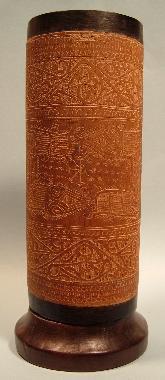
An Enigma
A number of years ago I bid on and won several interesting objects from an
eBay seller who specialized in estate sales. This particular estate
batch included a number of Precolumbian artifacts, mostly from the Costa Rica
Atlantic Watershed region -- but there were some other odd lots in it that caught my eye.
One was a mysterious hollow cylindrical container with a solid ebony base,
about 6" tall by 2" in diameter. The cylinder was formed from bamboo and
had a thin incised wood veneer wrapped and pasted around it. Judging from the
style of the incised designs, it appeared Polynesian or Indonesian, or
possibly from the Philippines, New Zealand, Malaya or New Guinea. The
primary figure on its frontside is a pair of very stylistic creatures
(dragons?)
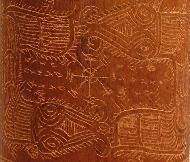 encircling
a simple 8-pointed "compass rose". Interesting enough by itself, but
"primitive" arts & crafts donít normally do much for me. It was rather
crudely made, and therefore hard to tell exactly how old it is; it might be a
hundred years old, or just a few years old. I have since searched the
web for its like and have never seen one. encircling
a simple 8-pointed "compass rose". Interesting enough by itself, but
"primitive" arts & crafts donít normally do much for me. It was rather
crudely made, and therefore hard to tell exactly how old it is; it might be a
hundred years old, or just a few years old. I have since searched the
web for its like and have never seen one.
I did some research and concluded that this is very likely an article known
as a "lime container." Maybe you are smarter than me, but as God is my
witness, my first thought when I ran into that term was that it was something
you used to keep green lime fruit in. Not! It is for storing
crushed seashells (mineral lime), to use when chewing Betel leaves. The
powdered lime activates a chemical in the leaves that produces a mild
stimulating effect when chewed. The substance is very addictive.
Betel chewing has been a common practice in Southeast Asia since at least the
time of Herodotus, and continues to this day. Lime (and the lime container)
has also been used in this same way in South America, but the leaf of choice
there is cocoa. My lime container must have had a cap at one time, but
it was lost. That's kind of a shame, because the caps of some of these
containers were truly works of art themselves.
The thing that got me going about this artifact was that it appeared to
have some sort of a table incised on its backside. The table is 30 cells
high by 12 wide. Some of the cells of the table are crosshatched, but
the balance have various symbols carved into them, which I took to be cursive
characters written in a language unrecognizable to me. Running
diagonally through the table are a number of straight incised lines every 7th
row, which "block out" the cells they run through, leaving 6 open cells
between the diagonals in any given column. The full matrix pattern, with
the crosshatched cells, is shown below: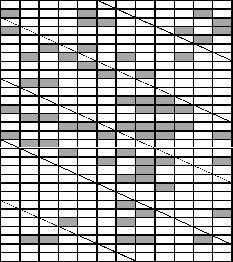
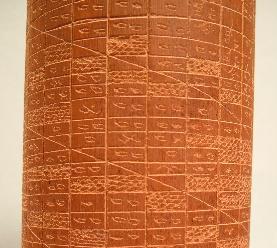
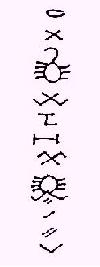
All the cells that either do not have a diagonal line running through them
or are crosshatched out have symbols in them. Most often, there are two
symbols together. Lots of "0-0"s and "0-X"s, but others as well. I
tried to transcribe the various symbols here. The symbols on the table that look like little
7-legged bugs always appear on top of each other, spanning 4 rows vertically
in a given column, as shown to the right. They probably comprise only
one character instead of the two I've shown to the left. This implies to
me that the cells are meant to be read vertically -- either up-to-down or
down-to-up. This symbol spans across cells (the only one to do so), and
therefore I suspect that the 4 cells are to be read or sequenced in vertical
order. Iím not sure why I think this set of symbols is a number set,
other than that there are only 10 of them (if you merge the 2 bugs into one
character). That of course presumes a base-10 number system. Iíve
managed to find examples of cursive numbers from a number of Southeast Asian
languages, and have ruled them all out. I havenít yet hit on the source
of these characters.
various symbols here. The symbols on the table that look like little
7-legged bugs always appear on top of each other, spanning 4 rows vertically
in a given column, as shown to the right. They probably comprise only
one character instead of the two I've shown to the left. This implies to
me that the cells are meant to be read vertically -- either up-to-down or
down-to-up. This symbol spans across cells (the only one to do so), and
therefore I suspect that the 4 cells are to be read or sequenced in vertical
order. Iím not sure why I think this set of symbols is a number set,
other than that there are only 10 of them (if you merge the 2 bugs into one
character). That of course presumes a base-10 number system. Iíve
managed to find examples of cursive numbers from a number of Southeast Asian
languages, and have ruled them all out. I havenít yet hit on the source
of these characters.
I havenít a clue what this table signifies. The total number of cells
(360) and table size (30X12) leads me to think it may represent some kind of
calendar, perhaps one that records festivals or holidays or some other
annually recurring event. I think some cultures used a 360-day calendar,
with a 5-day "uncounted period" slipped in at the end. Is this an
almanac of some kind? A tide chart or lunar calendar? A weather
record? But 50 of the cells are crossed through by the diagonals and
could therefore be "void", leaving only 310 "active" ones. Maybe those
are the "days of rest" in each vertical 7-day column-week? There are 63
cells "crosshatched out" -- whatever that signifies.
Maybe the container was originally made with a blank table, and the owner
used it as a dairy, recording some particular information on it. A
record of fish caught? A book of accounts? There are 360 degrees
in the compass, and perhaps that's a clue -- particularly in conjunction with
the "compass rose" appearing on the frontside. Could it be a map?
A sequence of particular movements, directions, gestures? Is this an
eclipse predictor, or some astronomical or astrological calculator? A
mathematical "times" table? A game? Directions to a fabulous
treasure? A prayer guide, akin to a rosary? The secret gnosis
of the 7th Heaven?
The other thing to notice is that the table doesn't "wrap around" properly,
such that its diagonals merge into one continuous spiral if the table were
turned into an edge-connected rolled cylinder. That's true when wrapping
either left-to-right or bottom-to-top. The wrapped diagonals are
displaced by 2 cells, either way. This fact really assaults my sense of
symmetry, and makes this conundrum even tougher to figure out! But could
this fact actually be a clue to the pattern?
What is perhaps most intriguing to me is the non-repetitive nature of the
crosshatched cells. But Iím not even sure where you start to read the
table, or whether the diagonals serve to enforce a modulo that you must
follow as you work your way through it. So I don't know how to "sequence
out" those hatched cells.
Certainly, this puzzle is stranger than any I've run into in playing
Myst. The artifact is truly an enigma to me, and I can only hope
that Iíll run into the explanation somewhere or sometime -- if not in this
life, then in the next one. If you can solve it, let me know please!
Back
to Loose Ends...
Postcript 5/23/05:
After spending all day long once again investigating the
origins of the characters, design motif and materials of this strange piece, I
finally fell across the answer to the mysery. The object turns out to be
a Vinoti/Batak Medicine Container from Northern Sumatra. Here are some
images of similar articles:
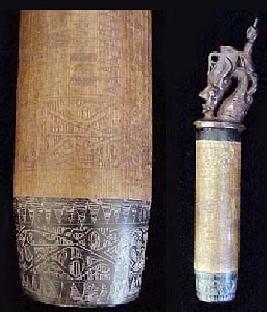
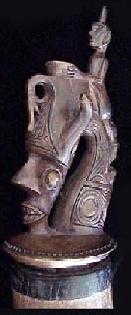
A classic Batak talismanic ancestral figure rides the legendary Naga
beast on the stopper of the above Lake Toba Batak medicine container.
Complex Batak designs etched into surface of bamboo look just like the ones on
mine. Included is a calendar that marks significant days for the use and
non-use of the tube's contents. This one measures about 12 inches
overall. Toba Batak magician-priests called datu used containers
like this to hold ritual potions. In this society, only the priests are
allowed to learn and use the Batak written language symbols.
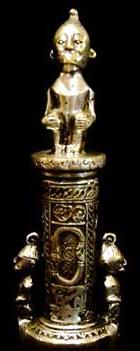 These
containers feature a traditional Singa, a protective image of the
Dragon/Lion deity that the Batak people adopted into their own spiritual
cosmos after trade with the Indian continent. The figures incised on the
front of my container may be 2 of these mythical figures. I found an
image of a Batak medicine container made of silver that appears to have the
same "tail eating dragons" on it, at left. These
containers feature a traditional Singa, a protective image of the
Dragon/Lion deity that the Batak people adopted into their own spiritual
cosmos after trade with the Indian continent. The figures incised on the
front of my container may be 2 of these mythical figures. I found an
image of a Batak medicine container made of silver that appears to have the
same "tail eating dragons" on it, at left.
Perhaps the most interesting find was an image of a Vinoti/Batak book made
with ink on bark paper. It's turned to a page with a calendar table.
It shows exactly the same diagonal lines and character symbols I saw on
my container -- including the little 7-legged bugs!
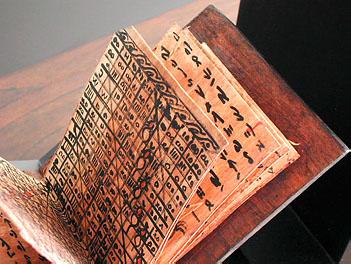
I found some additional information on the
Batak calendar:
"Originating in
India, the Batak calendar takes into account the succession of the seasons and
the time for the planting of the rice. There are three different years. The
Great Year of 360 days, the Rice Year of 6 to 7 months and the Maize year of 3
to 4 months. In fixing a good day for a Feast, the datus also took into
account the position of the stars. The Calendar, (Porhalaan) was carved on a
piece of bamboo and shows a number of small squares, 12 or 13 lengthways
denoting the months, and 30 across denoting the days. The Bataks also have a
lunar year, which begins when the constellations of Orion and Scorpio appear
in the sky together, the former in the western sky, the latter in the east.
When the crescent moon in the west passes north of Orion, we have the
beginning of the first month of the Batak year (April.) The Batak calendar is
not a calendar in the modern sense of the word. Rather, it is a diviner's
instrument to decide whether a day will be auspicious or not. The diviner was
consulted before any important event: The planting of rice; the fixing of a
wedding day; the building of a new house; the laying out of a new village; a
sacrificial ceremony in connection with a birth; a name giving; a burial; an
exhumation of bones. (a practice which is still continued in certain places.)
The calendar is only used to fix a favorable day for the start of an
undertaking, not for its continuation. The various calendars sometimes differ
in detail but all have the 12 or 13 months and the 30 days. The 7th day is
always unfavorable and no important undertaking should be started on that day.
The differences between calendars gives the datus a chance of proving
that their calendar is the best. Not all datus have the months begin on
the same day. The calendar shows a number of empty squares. Those days promise
well for the future. In between are squares which show symbolic figures and
Batak letters, and these days may be lucky, doubtful or unfavorable."

| 